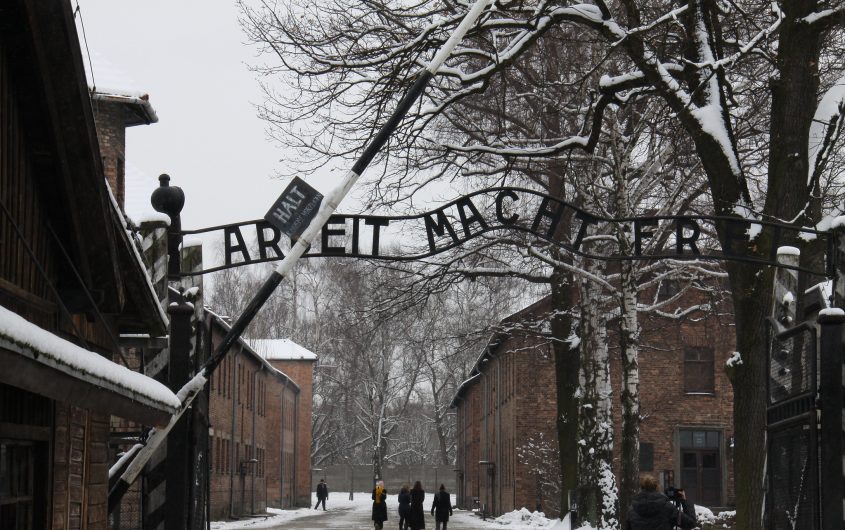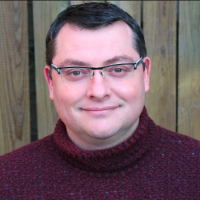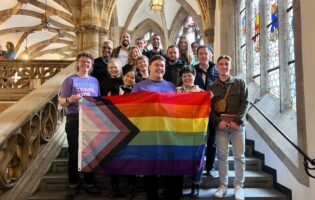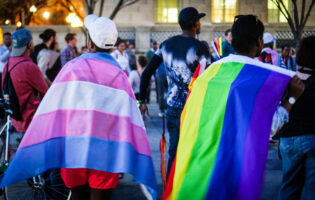
U.S. Department of State via Flickr
Keeping History Alive: 75 Years after the Liberation of Auschwitz

Eric Langenbacher
Senior Fellow; Director, Society, Culture & Politics Program
Dr. Eric Langenbacher is a Senior Fellow and Director of the Society, Culture & Politics Program at AICGS.
Dr. Langenbacher studied in Canada before completing his PhD in Georgetown University’s Government Department in 2002. His research interests include collective memory, political culture, and electoral politics in Germany and Europe. Recent publications include the edited volumes Twilight of the Merkel Era: Power and Politics in Germany after the 2017 Bundestag Election (2019), The Merkel Republic: The 2013 Bundestag Election and its Consequences (2015), Dynamics of Memory and Identity in Contemporary Europe (co-edited with Ruth Wittlinger and Bill Niven, 2013), Power and the Past: Collective Memory and International Relations (co-edited with Yossi Shain, 2010), and From the Bonn to the Berlin Republic: Germany at the Twentieth Anniversary of Unification (co-edited with Jeffrey J. Anderson, 2010). With David Conradt, he is also the author of The German Polity, 10th and 11th edition (2013, 2017).
Dr. Langenbacher remains affiliated with Georgetown University as Teaching Professor and Director of the Honors Program in the Department of Government. He has also taught at George Washington University, Washington College, The University of Navarre, and the Universidad Nacional de General San Martin in Buenos Aires, Argentina, and has given talks across the world. He was selected Faculty Member of the Year by the School of Foreign Service in 2009 and was awarded a Fulbright grant in 1999-2000 and the Hopper Memorial Fellowship at Georgetown in 2000-2001. Since 2005, he has also been Managing Editor of German Politics and Society, which is housed in Georgetown’s BMW Center for German and European Studies. Dr. Langenbacher has also planned and run dozens of short programs for groups from abroad, as well as for the U.S. Departments of State and Defense on a variety of topics pertaining to American and comparative politics, business, culture, and public policy.
__
One of the negative icons of the twentieth century was the Holocaust—the Nazi German persecution and murder of approximately 6 million Jewish people in Europe during World War II from 1939-1945 (although persecution began with the Nazi takeover in 1933). The Nazis targeted millions more—homosexuals, political opponents, mentally disabled, Sinti and Roma, members of resistance movements in occupied countries, Red Army POWs, eastern European civilians—but there was something uniquely awful about the Nazis’ virulent anti-Semitism and targeting of Jews. There has never been another crime like the Holocaust—the purposeful mass killing of a religious minority with the intent of eliminating an entire population and culture.
MORE FROM AGI ON MEMORY OF THE HOLOCAUST AND AUSCHWITZ
No place encapsulates Nazi German crimes like the concentration and death camp of Auschwitz-Birkenau located in Oświęcim near Krakow in southern Poland. It was the last major death camp to be liberated just three months before the end of the war. It had the largest number of victims with approximately 1.1-1.3 million murdered. And it has become iconic through survivor testimonies and literary works, as well as being featured in significant films like Schindler’s List. For many people worldwide, Auschwitz is synonymous with the Holocaust and Nazi German crimes. In fact, one of the most important international Holocaust commemoration days is the date of its liberation.
For many people worldwide, Auschwitz is synonymous with the Holocaust and Nazi German crimes.
January 27, 2020, marks the 75th anniversary of the liberation of the Auschwitz-Birkenau concentration and death camp by members of the Soviet Union’s Red Army. They encountered a horrific wasteland with only a few thousand inmates left. (The Nazis had evacuated and forced many inmates on death marches toward the west). Many of the buildings, including the infamous crematoriums used in the Birkenau extermination camp, were blown up or set on fire. Despite these efforts to conceal the crimes, clear evidence of what had happened remained. The original concentration camp (Auschwitz)—an army camp already during World War I when the region was part of Austria-Hungary and later used by the Polish army—was largely intact and became the basis for the State Museum of Auschwitz-Birkenau, founded in 1947 and opened in 1955. Today, the museum and memorial is one of the most-visited in Poland with over 2 million visitors.
The site and commemorations have long generated intense debates. Most generally, the debates have centered around to whom the museum and memorial should be dedicated and whose narrative should be foregrounded. For the decades under communist dictatorship, a highly ideological and gentile Polish narrative was emphasized. Some even said that the decision to focus the museum on the concentration camp portion—where inmates from around Europe and Poland were incarcerated—diluted the specific Jewish dimension of the tragedy. The vast majority of victims—approximately 90 percent of those murdered—were Jewish. There have also been many instances of Christians—in deeply Catholic Poland—attempting to assert their religious and commemorative practices on the site. Notable examples include Pope John Paul II holding mass at Birkenau in 1979 and a Carmelite nunnery being established just outside of the grounds and erecting a very visible and large cross. Despite years of debate, the tension between Auschwitz being seen as a symbol of Polish/international suffering, Jewish victimization, or even as a timeless, international symbol of human brutality will likely never go away.
The tension between Auschwitz being seen as a symbol of Polish/international suffering, Jewish victimization, or even as a timeless, international symbol of human brutality will likely never go away.
From the Polish side, there has long been anger when people erroneously refer to places like Auschwitz as a “Polish” concentration camp. The government has lobbied international organizations and even passed laws to push back on such inaccuracies, perhaps overshooting in an illiberal direction. Presently, the site is clearly referred to as “Former German Nazi Concentration and Death Camp”—although one has to wonder why it is “German Nazi” rather than “Nazi German.”
And maybe these tensions ought not go away. I’m reminded of James Young’s comment that the best German memorial to the Holocaust is an on-going debate and discussion about how to commemorate such a horrible crime against humanity. Differences of opinion and the emotion invested in various positions are the surest means to keep history alive through a kind of living memory. We feel memory; we know history. Memory is the living past; history is the dead past.
Differences of opinion and the emotion invested in various positions are the surest means to keep history alive through a kind of living memory.
On this 75th anniversary, it is essential to keep the memory of Auschwitz, Nazi German crimes, and the Holocaust alive. Most of the survivors and witnesses have passed on. Few memories are as highly institutionalized in the memorial landscape, the commemorative calendar, and school curricula. Younger generations across Europe and the world increasingly learn about these horrific events as a kind of duty, rather than engage with these events with emotive outrage and a desire to continue the most important lesson that arose from the horror—“never again.”
Especially in 2020, with the alarming rise of anti-Semitism and violent acts against Jewish people and other minorities across the world, as well as the rise of right radical, nationalist parties in many countries, it is vital to remember what happened then and to re-dedicate ourselves to the “never again” lesson. We have to actively combat perspectives like that expressed by Alternative for Germany (AfD) leader Alexander Gauland who recently referred to the Nazi era as “bird shit” in 1,000 years of German history. Other AfD politicians have criticized a “memory dictatorship” and the “cult of guilt.”
We need to be vigilant when the liberal democratic order—especially the protections for various minority groups—is eroded or actively subverted.
Germany and the world community cannot sit silently when we hear such rhetoric. We cannot ignore massive human rights abuses wherever they occur. We need to be vigilant when the liberal democratic order—especially the protections for various minority groups—is eroded or actively subverted. We need to remember the innocent victims and everything that was lost and ensure that it never happens again. This is the message that we should always remember, but especially on such a tragic anniversary as the 75th anniversary of the liberation of Auschwitz.









